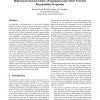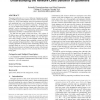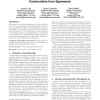45 search results - page 1 / 9 » Behavioral Characteristics of Spammers and Their Network Rea... |
ICC
2007
IEEE
13 years 11 months ago
2007
IEEE
By analyzing a two-month trace of more than 25 million emails received at a large US university campus network, of which more than 18 million are spam messages, we characterize th...
SIGCOMM
2006
ACM
13 years 11 months ago
2006
ACM
This paper studies the network-level behavior of spammers, including: IP address ranges that send the most spam, common spamming modes (e.g., BGP route hijacking, bots), how persi...
CEAS
2008
Springer
13 years 7 months ago
2008
Springer
Social networking communities have become an important communications platform, but the popularity of these communities has also made them targets for a new breed of social spamme...
WWW
2010
ACM
13 years 12 months ago
2010
ACM
We present the conceptual framework of the Social Honeypot Project for uncovering social spammers who target online communities and initial empirical results from Twitter and MySp...
SIGIR
2010
ACM
13 years 8 months ago
2010
ACM
Web-based social systems enable new community-based opportunities for participants to engage, share, and interact. This community value and related services like search and advert...



